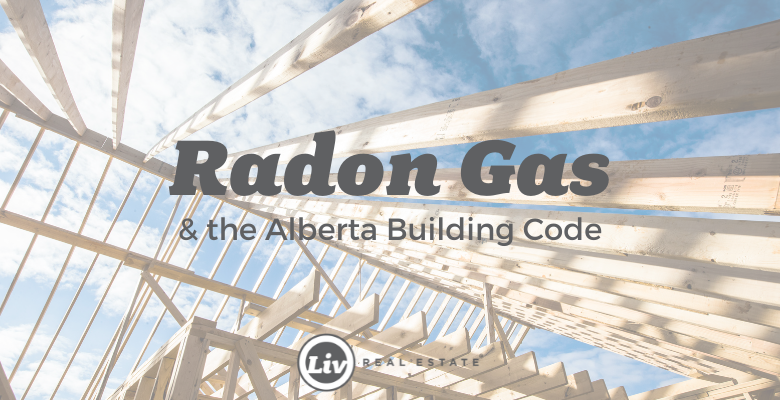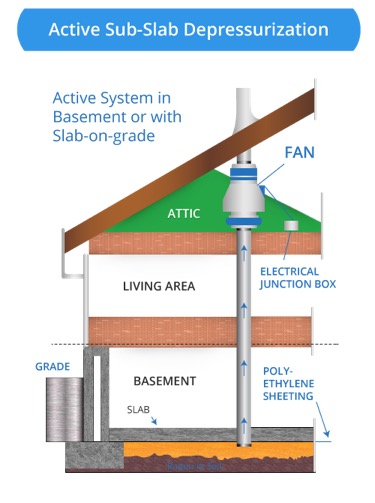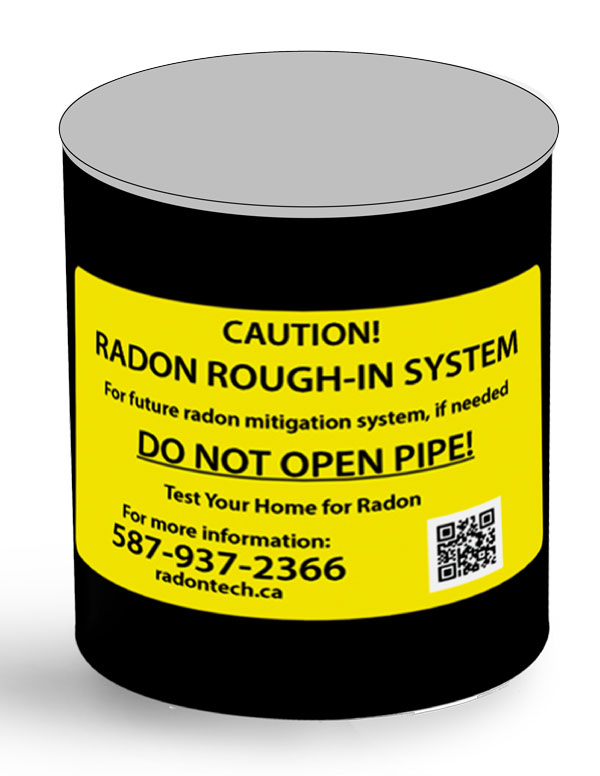
What is radon gas?
Radon is an invisible, odourless, cancer-causing, radioactive gas that comes from the ground. When inhaled, radon breaks down into radioactive particles, releasing bursts of radioactivity that can cause injury to lung tissue. Exposure to high levels of radon is the second leading cause of lung cancer after tobacco smoking. Radon enters homes where the house comes into contact with the ground and can accumulate into high levels, posing health risks to the occupants. The health implications of radon exposure depend on both the level and length of exposure, and the risk of developing lung cancer is especially high for smokers. The only way to find out if your home has high radon levels is to have your home tested. A reading of 200 Bq/m3 or higher indicates that you should reduce radon levels.How to test radon levels
You can buy a kit at a home improvement store, order one online or have it done by a professional. The test kit should stay in your home for at least 90 days before it’s sent to a lab for testing (some test kits have a speedier time frame, but they are considered less accurate). Note - Not all test kits are equal. Make sure you purchase your kit from a reliable source, check out online reviews and carefully read the instructions before beginning to avoid delays and additional laboratory fees.How to reduce high radon levels
High levels of radon can be successfully reduced by installing a radon-reduction (mitigation) system. Typically, this involves installing a vent pipe that exhausts radon from underneath the house to outside, preventing it from getting into the house. This system is a one-install solution that becomes part of the house systems, just like a furnace or water heater. The type of radon mitigation system depends on the construct of the home where the house meets the ground. Homes with slab foundations are typically mitigated by installing the vent pipe through a hole made in the foundation slab (also known as active sub-slab depressurization or ASD). This method has been shown to reduce radon levels in homes by an average of 91%. In Canada, radon is recognized as a health risk. Despite radon exposure being responsible for more deaths (more than 3,000 per year) than carbon-monoxide (50 per year), awareness levels still remain low among Canadians. However, various prevention strategies have been developed, included changes to building codes.
In Canada, radon is recognized as a health risk. Despite radon exposure being responsible for more deaths (more than 3,000 per year) than carbon-monoxide (50 per year), awareness levels still remain low among Canadians. However, various prevention strategies have been developed, included changes to building codes.
New Alberta Building Code requirements to protect against radon
The Alberta Building Code 2014 has adopted new requirements to protect new homes from radon. These requirements came into effect on November 1st, 2015. These new requirements are in place to minimize radon entry into homes, and to provide for a radon mitigation rough-in pipe to make it easy to install an effective radon reduction system should testing reveal the presence of a high level of radon. The new building code requirements relating to radon require new homes to be built with the following features:- Gravel sub-membrane layer: This allows for proper venting of the whole sub-floor from suction through one hole should an active mitigation system be installed (vent pipe with a fan).
- Poly-membrane beneath the slab: Which provides an air barrier that minimizes radon entry.
- Proper sealing around wall-floor joints: This requires sealing up to the foundation wall to minimize radon entry
- Properly sealed and labelled radon pipe: The radon pipe should be at least 100mm in diameter and should run underneath the floor up to the mid-point of the home. Sealing the pipe prevents inadvertent radon entry. Labelling clarifies the purpose of the pipe to prevent inappropriate use, like hooking up a toilet.
- Properly located radon rough-in or passive pipe: Which makes it easy to access and install an active system, should one be required.
What you will see in new homes
If you are buying a new home built according to the new standard, you should expect to see a sealed and labelled rough-in radon pipe in the basement. It is important to note that this is not a mitigation system. It is a rough-in mitigation pipe that can be linked to a radon mitigation system should it be needed in the future.
While the building code provisions will significantly reduce the chances of radon getting into a home, it is impossible to prevent radon entry completely. Radon is a gas - a million radon atoms can fit into a hole the size of the width of a human hair. It may still find entry into a home despite preventative efforts.
Homeowners should understand that they should test their home for radon to decide if they need to complete the radon mitigation system. If testing reveals high radon levels, a mitigation system can be connected to the rough-in by attaching a vent pipe and fan to the roughed-in pipe to discharge radon outside of their home.
There are important considerations involved in properly installing an effective, efficient, and long-lasting mitigation system. Homeowners should look for a mitigation professional who is certified by the Canadian National Radon Proficiency Program (C-NRPP) to complete the job.
Ultimately the rough-in reduces the time and effort required for installing an active mitigation system, thereby reducing costs associated with radon mitigation.
Posted by Liv Real Estate
on
It is important to note that this is not a mitigation system. It is a rough-in mitigation pipe that can be linked to a radon mitigation system should it be needed in the future.
While the building code provisions will significantly reduce the chances of radon getting into a home, it is impossible to prevent radon entry completely. Radon is a gas - a million radon atoms can fit into a hole the size of the width of a human hair. It may still find entry into a home despite preventative efforts.
Homeowners should understand that they should test their home for radon to decide if they need to complete the radon mitigation system. If testing reveals high radon levels, a mitigation system can be connected to the rough-in by attaching a vent pipe and fan to the roughed-in pipe to discharge radon outside of their home.
There are important considerations involved in properly installing an effective, efficient, and long-lasting mitigation system. Homeowners should look for a mitigation professional who is certified by the Canadian National Radon Proficiency Program (C-NRPP) to complete the job.
Ultimately the rough-in reduces the time and effort required for installing an active mitigation system, thereby reducing costs associated with radon mitigation.
Posted by Liv Real Estate
on

Leave A Comment